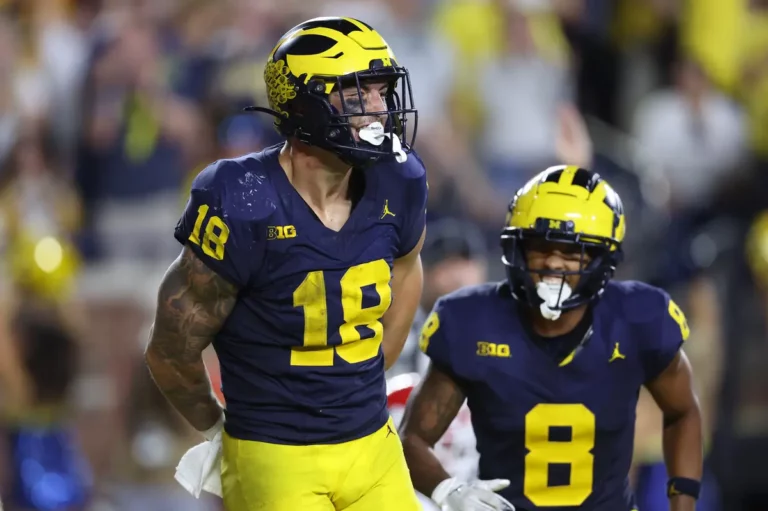Every avid fantasy footballer has experienced it: You have a great week and outscore almost everybody in your league… except your opponent.
You feel good about your team’s performance, but it feels wrong to have come away with the same result as the guy who barely scored 80 points. Many people say, “That’s just how fantasy football works,” but I am not satisfied with that answer. Neither is the crew over at Sleeper, who has popularized the idea of a league median.
WHAT IS A LEAGUE MEDIAN?
Under a league median, you still play your opponent each week and get a win or loss depending on the head-to-head result. But, each week, you have another game against the league median score. If you score more than the league median, you get an additional win. So, the total number of games each season is doubled, and everything else follows as normal.
It can be hard to understand at first, so I will give an example. For simplicity’s sake, I will use a four-team league, but obviously, this works in the same way with any amount of teams.
- Team A – 80 points vs. Team B – 90 points
- Team C – 100 points vs. Team D – 110 points
Given these matchups in a normal league, Team B and Team D would get wins for their matchup. But, under league median, it would be a little different.
Team B and Team D would still receive wins for their matchup. However, only Team C and Team D beat the median score of 95 points (this number is automatically calculated and displayed, so no extra work for you commissioners). They would receive the second win for their efforts that week, as they were above-average teams. The standings for the week would look like this:
- Team D – (2-0)
- Team C – (1-1)
- Team B – (1-1)
- Team A – (0-2)
Now, Team B and Team C are on the same level, because one outscored a poor opponent while the other did well, but could not defeat a great performance. This can up the competitiveness of the league, where below-average teams that get lucky do not outdo above-average teams that are unlucky throughout the season.
WHY I SHOULD ADD LEAGUE MEDIAN?
Competitiveness and Fairness
The most common reason for adding league median is to minimize the ‘luck’ factor in fantasy football. People are betting more and more money nowadays on fantasy football and with more resources to improve your team than ever, players want to be rewarded for their efforts. I would hate to bet a lot of money on my league just to miss the playoffs to a team who had the fewest points against them all season.
Some people say that luck is a part of the game. This is true, and that is why it is still worth half of your wins for the week. League median does not defeat the purpose of matchups; it just makes it more fair between teams across the league and how they perform. There will still be lucky and unlucky teams, but it minimizes the chance one of those teams is the reason you do not make the playoffs.
For more casual leagues, this may not be what you want. With people who are new to fantasy or do not take it too seriously, the luck factor is the most fun part. This change is mostly for advanced leagues with teams who spend time each week crafting their lineup and betting money on the season.
Engagement
League median also had another effect: Keeping teams engaged throughout the week. There are two ways in which this can occur.
Oftentimes, after the 4 o’clock Sunday slate has ended, the result of your matchup is already decided. After all, only Sunday Night and Monday Night Football remain and there are far fewer players yet to play. This is when many managers check out, letting it play out without much care.
With league median, though, every player matters, as it affects the score you are going against. Every team in the league is essentially your opponent, as the median of their scores is what you are up against for your second win.
Here’s an example, from personal experience: You have already lost your matchup. You did well, but your opponent just had a great week, maybe that time Tyreek Hill had 57.9 points or when Alvin Kamara put up six touchdowns. There’s just no competition with that result.
But with league median, you still have another matchup. After implementing last season, I spent multiple weeks watching SNF and MNF hoping my players would score enough to still go (1-1) on the week and come away somewhat satisfied.
When you come away with two wins in a week, you feel like you are on top of the world. When you end up with zero wins, you lost to your opponent and the league. So, there’s no complaining — league median accentuates the idea of “put up or shut up.”
And on the other side, when I did not have any players left, I often found myself watching other teams’ players and rooting against them so my score would remain above the league median. By the end of the season, I knew almost every team’s entire roster just from median-watching. It made it much more fun to text to group chat when you knocked somebody down from above to below the median, essentially handing them a loss in a week you did not even play them.
CONCLUSION
If you have a dedicated league, adding a median could completely change the game. The ability to battle with everybody in the league at once while still maintaining your matchup integrity takes competitiveness to the next level.
Of the major platforms, only Sleeper and ESPN currently have the option to add a league median. You can always manually change the playoffs on other platforms to adjust, but this is a pretty major undertaking for your league commissioner.
If you run a league or are part of a league that you feel needs a league median, talk about it with your fellow managers and explain how it works. It can be game-changing for your fantasy experience and more importantly, your wallet.































